According provided by Tokina AT-X PRO AF 28-70mm 1: 2.6-2.8 lens (Tokina AT-X 270 AF PRO N / AIS) many thanks to Andrei Tverdokhleb.
Navigation
- In short
- History
- Main Specifications
- Assembly / management
- Focusing
- Image quality
- Sample Photos
- My personal experience with the lens
- Prices
- Alternatives
- Results
- User Comments
- Add your review or question on the lens
In the review, the Tokina AT-X PRO AF 28-70mm 1: 2.6-2.8 lens will be abbreviated as Tokina AT-X 270 AF PRO (according to the official name).
In short
The Tokina AT-X 270 AF PRO is an old professional, fast, versatile lens for full-frame film cameras. Legendary model from Tokina. Excellent build quality, but many features with image quality.
At one time, the Tokina AT-X 270 AF PRO was one of the fastest universal photo lenses. Its marking indicates 1: 2.6-2.8, which theoretically allows the use of a relative aperture of 1: 2.6 per 28 mm of focal length. Such aperture he inherited from his ancestor - the legendary Angenieux Zoom F.28-70 1:2.6 AF... However, with the Tokina AT-X 270 AF PRO, not everything is so rosy:
- F / 2.6 only available at 28 mm focal length
- F / 2.6 is just 1.16 times lighter than the classic F / 2.8 value. Is it worth chasing 16% (1/6 stop) aperture in the wide-angle range?
- in terms of real apertureexpressed in T-stops, there is practically no gain
- on most modern cameras, the menu will show F / 2.8 instead of F / 2.6. The standard F-numbers for modern cameras are F / 2.5 and F / 2.8 (no space between them)
- the same lens was produced for Japan with marking Tokina AT-X PRO AF 28-70mm 1: 2.8 (the same Tokina AT-X 270 AF PRO model), while users may not have guessed that F / 2.6 is actually used instead of F / 2.8
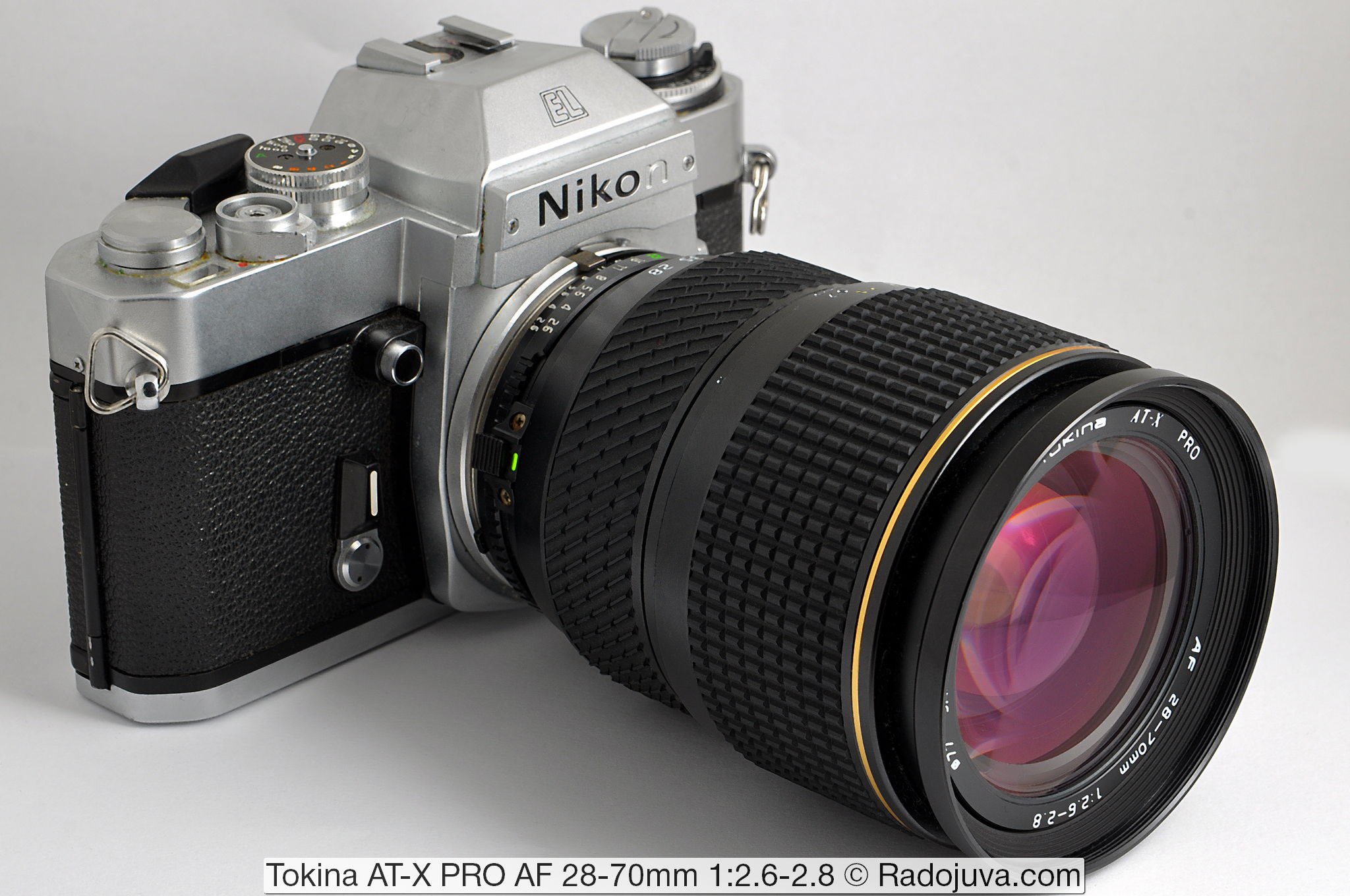
Tokina AT-X PRO AF 28-70mm 1: 2.6-2.8 (Tokina AT-X 270 AF PRO). Lens shown on a film SLR camera Nikon EL2.
History
Tokina AT-X 270 AF PRO was produced since 1994.
There are a fairly large number of such lenses from Tokina. The difficulty in identifying a particular instance is due to the fact that some of them are very similar in appearance, and lenses were marked differently for different countries. For some lenses (depending on the target country), the maximum aperture F / 2.6 for 28 mm focal length.
The evolution of Tokina Class 24 (28) -70 (80) /2.8 (2.6-2.8) lenses:
- Tokina AT-X AF 28-70mm 1: 2.8 - orange border near the front lens, filter diameter 72 mm, focusing is not internal. Window focusing distances. The name on the box is Tokina AT-X 270 AF.
- Tokina AT-X PRO AF 28-70mm 1: 2.6-2.8 (1: 2.8) - marking '1: 2.8' for Japan, marking '1: 2.6-2.8' for other countries, filter diameter 77 mm, internal focusing. The hood is threaded. Without a window of focusing distances, a gold border near the front lens. The name on the box is Tokina AT-X 270 AF PRO. You can distinguish on these signs of.
- Tokina AT-X PRO 28-70mm 1: 2.6-2.8 (1: 2.8) - marking '1: 2.8' for Japan, marking '1: 2.6-2.8' for other countries, filter diameter 77 mm. Externally similar to the previous version, but there is no 'Tokina' lettering near the front lens, and the hood is bayonet type. The version is commonly referred to as 'AT-X PRO II'. Name on the box Tokina AT-X 270 AF PRO II. You can distinguish on these signs of.
- Tokina AT-X PRO 28-80 1: 2.8 Aspherical - a window of a focus scale, a gold border near the front lens. The name on the box is Tokina AT-X 280 AF PRO. There is a subversion with a gold nameplate with the name of the lens and other enlightenment.
- Tokina AT-X PRO SV 28-70mm 1: 2.8 (also called Tokina AT-X 287 PRO SV) - easily recognized by the 'PRO SV' prefix. Name on the box Tokina AT-X 287 AF PRO SV.
- Tokina SD 24-70 F2.8 (IF) FX AT-X PRO Aspherical - easy to find by focal lengths. Has a built-in focus motor. Name on the box Tokina AT-X 24 ~ 70mm F2.8 PRO FX
As indicated above, the versions of Tokina AT-X 270 AF PRO and Tokina AT-X 270 AF PRO II exist in two versions: '1: 2.8' and '1: 2.6-2.8' and are quite similar to each other. The easiest way to distinguish between 'PRO' and 'PRO II' is by the inscription 'TOKINA' near the front lens and the presence of fasteners for the bayonet hood:
It is worth remembering about Angenieux Zoom F.28-70 1:2.6 AF, which is the progenitor for some models from the list above.
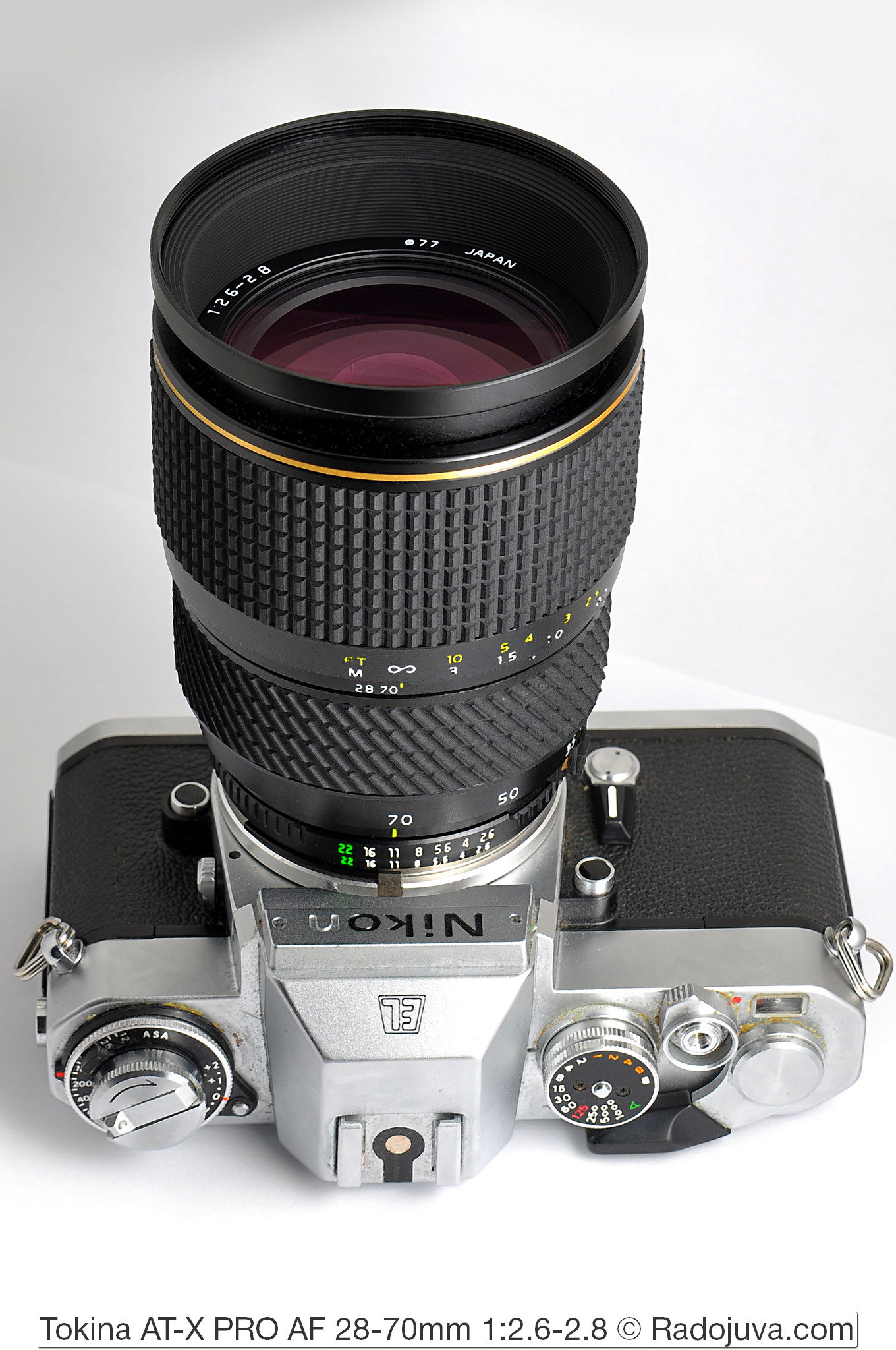
Tokina AT-X PRO AF 28-70mm 1: 2.6-2.8 (Tokina AT-X 270 AF PRO). Lens shown on a film SLR camera Nikon EL2.
Main Specifications
| Review Instance Name | Tokina AT-X PRO AF 28-70mm 1: 2.6-2.8 ø77 Japan 5612397 N / AIS |
| Basic properties |
|
| Front Filter Diameter | 77 mm, metal thread for filters |
| Focal length | 28-70 mm EGF for Nikon DX cameras is 32-105 mm |
| Zoom ratio | 2.5 x |
| Designed by | for film and digital full-length cameras (available in versions for Canon, Minolta / Sony, Nikon and Pentax). A good review of the version for Canon cameras can be found on the website. Vlador.com |
| Number of aperture blades | 8 straight petals that form a fairly regular octagonal hole |
| Tags | focusing distance in meters and feet, focal lengths for 28, 35, 50, 70 mm, aperture setting mark (it is also a bayonet mount mark), aperture value, three marks (28, 50, 70 mm) for working in infrared spectrum. |
| Diaphragm | the camera can be set from F / 2.8 over the entire range of focal lengths to F / 22. The lens has an aperture ring (Non-G - lens type) On the aperture ring there are marks F / 2.6, 4, 5.6, 8, 11, 16, 22. The ring has no intermediate values. |
| MDF (minimum focusing distance) | 0.7 m over the entire range of focal lengths |
| The weight | November 760, XNUMX |
| Optical design | 16 elements in 12 groups. One (or several?) Elements are made of HLD glass (High Refractive Low Dispersion)
The same optical scheme is used for lenses:
|
| Lens hood | MH773, screwed into the front filter thread |
| Manufacturer country | JAPAN (Japan) |
| Period | Since 1994, it was later replaced by Tokina AT-X 270 AF PRO II |
| Price | Not for sale, used options sell at 200-400 cu Prices for modern Tokina lenses can be viewed here. |
All Tokina 28-70 / 2.6 (2.8) lenses are based on the same optical design.
Assembly / management
Tokina AT-X 270 AF PRO has a very high quality build. The mount is made of chrome-plated brass. The inner frame is made of duralumin. The remaining parts are made of durable composite materials. Many users are very attracted by the pleasant tactile sensation when working with similar Tokina lenses. True to the touch Tokina AT-X 280AF PRO performed even better.
During a change in focal length, the front lens moves in a wave-like fashion, but does not extend further than the front of the barrel, and therefore does not increase the overall dimensions of the lens. The maximum lens recess is available at 50-70 mm focal length and focusing at infinity (the effect of the built-in lens hood is obtained). The front lens is moved as close as possible to the edge of the body frame by 28 mm focal length and focusing on MDF. We can say that the lens has internal focusing and internal zoom and does not change its size. When changing the focal length, the rear lens moves, the effect of a vacuum cleaner is minimal.
Unlike the Tokina AT-X 270 AF PRO, the original Nikon / Canon class 24 (28) -70 / 2.8 lenses have a movable front frame (trunk), which does not look as stylish as the internal zoom of the Tokina AT-X 270 AF PRO
The lens has a manual aperture ring. To be able to control the value aperture from camera or for automatic installation aperture on modern central control valves, you need to turn the control ring to F / 22 and fix it with a special switch, which is located to the right of the marks aperture. The F / 22 value and the latch mark are highlighted in green to match them. If this is not done, then on a number of cameras, the display will display an error - 'fEE' (ring is not installed aperture) Some cameras having diaphragm rheostatallow you to control the aperture using the ring aperturebut only in metering modes exposure 'M' and 'A'. You can read more about this issue in the section on Non-G Lenses. Ring aperture rotates with clicks, F /2.6, 4, 5.6, 8, 11, 16, 22. Intermediate values can only be set using the camera menu.
The diaphragm consists of 8 straight lobes and forms regular 8-gons (sample photo on f / 5).
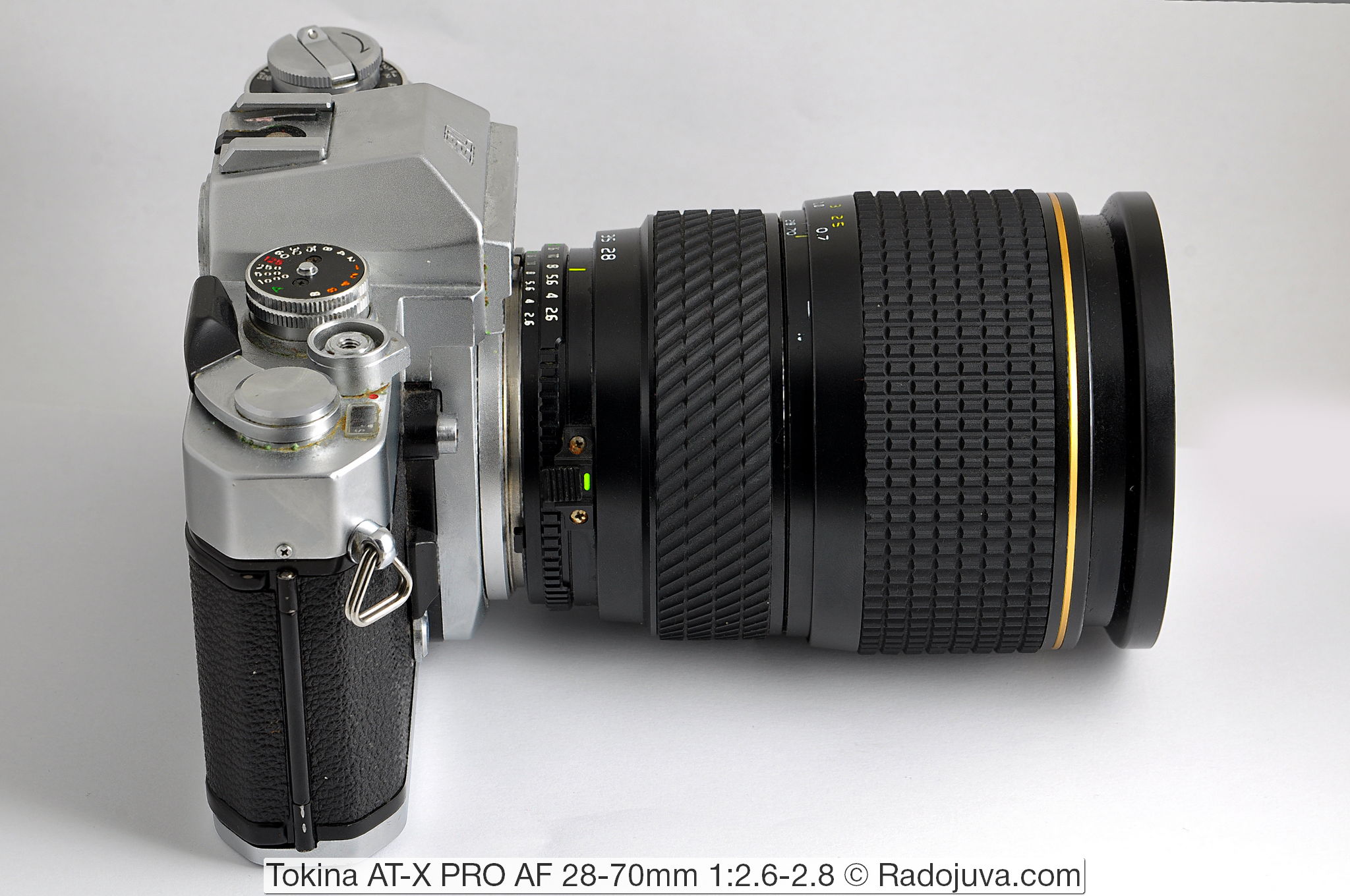
Tokina AT-X PRO AF 28-70mm 1: 2.6-2.8 (Tokina AT-X 270 AF PRO). Lens shown on a film SLR camera Nikon EL2.
Focusing
Auto focus is fast enough. During focusing, the front lens rotates and moves in the middle of the frame of the body (we can arbitrarily assume that the lens has internal focusing). In manual focus mode, the focus ring rotates 70 degrees. During auto focus, the focus ring can rotate freely between the extreme positions without affecting the focus. It is convenient to support the lens behind the focus ring.
There is a special Tokyo-based AF / MF One-touch focus clutch switch (one-touch focus mode switch). To switch between focus modes, just pull the focus ring toward the bayonet mount or front lens. The switch is uncomfortable. It will be possible to switch from automatic focus mode to manual only in the position of the focus ring in which the reverse transition was carried out. But you can switch from manual to automatic mode in any position of the ring (at any set focusing distance).
It's important: auto focus with this lens is available only when using him on cameras with built-in motor focusing.
Exact list Nikon DSLR cameras with a built-in focus motor, on which this lens will focus automatically:
- D1, D1h, D1x, D2x, D2xs, D2h, D2hs
- D3, D3x, D3s, D4, D4s, D5, D6
- Df
- D50, D70, D70s, D80, D90
- D7000, D7100, D7200,D7500
- D100, D200, D300, D300s,D500
- D600, D610, D750, D780
- D700, D800,D800E, D810, D810a, D850
- Fujifilm FinePix S1 Pro, S2 Pro, S3 ProS3 Pro UVIR, S5 ProIS Pro
- Kodak DCS PRO 14n, DCS Pro SLR/n
Exact list Nikon DSLR cameras without a built-in focus motor, on which this lens will not focus automatically:
Only auto focus and sound confirmation of focus will not work with these cameras, all other important functions, such as automatic exposure metering and automatic iris control, will work well.
You will find a lot of useful information on the types of cameras and lenses Nikon here.
Focus Features:
- Focus speed may vary slightly from the camera used. This issue has been considered. here.
- During focusing, the lens and camera are quite noisy. The noise level can be found in my video review of this lens.
- There is a small effect of 'Focus Breathing' (changing the viewing angle during focusing).
- Tokina AT-X 270 AF PRO is a third party lens. It may happen that it will not work correctly with some Nikon cameras. Details on this issue have been reviewed by me here.
- When changing the focal length, focusing is a bit confused.
- Tokina AT-X 270 AF PRO transmits the focus distance to the subject in the camera and is a type lens Nikon D.
- The lens has a scale with a focusing distance in meters and feet, as well as a mark scale for working in the infrared spectrum.
- I got a review with a lens with problems of adhesion with the focusing motor of the camera, as well as with a problem ring of the diaphragm, so I can not judge the accuracy, tenacity of focus.
Image quality
Optically, this instance does not shine, often in the pictures you can find the characteristic Tokinovsky software.
The range 70 / 2.8 can be used for portrait shooting, where the peculiar pattern of the lens can give the photo its zest.
Sample Photos
Pictures from Nikon D90... Photos in the gallery below are shown without processing, converting the original RAW files with the original Nikon ViewNX-i utility without making additional adjustments. Some of the photos were taken with two 'naked' cartridge flashes Godox s45t.
You can download the original 'jpeg' photos at this link.
My experience
Tokina AT-X 270 AF PRO is a pleasant lens to work with, but for those looking for an inexpensive omnivorous all-rounder for a wide range of tasks, I would recommend finding a good copy. Tamron SP AF Aspherical XR Di LD [IF] 28-75mm 1: 2.8 Macro A09. Many times I met photographers who were unhappy with the image quality from similar Tokina lenses. Some argued that there was some kind of disease in the optics of these models, which over time manifests itself in the alignment of lenses and the deterioration of image quality. You can write your thoughts on this in the comments on this review.
My other Tokina lens reviews are listed here.
Prices
Tokina AT-X 270 AF PRO can only be purchased in the used version. from 200 to 400 dollars, depending on the condition. Prices for modern Tokina lenses can be viewed here.
Comments on this post do not require registration. Anyone can leave a comment. Many different photographic equipment can be found on AliExpress.
Professional fast wagon
Choosing a good high-speed universal lens is one of the most important for a large number of photographers. I pay a lot of attention to this issue, because I prepared this list of all full-frame universal (standard range of focal lengths) fast autofocus lenses:
Canon
Bayonet EF:
- Canon Zoom Lens EF 28-70 mm 1: 2.8 L USM
- Canon Zoom Lens EF 24-70 mm 1: 2.8 L USM
- Canon Zoom Lens EF 24-70 mm 1: 2.8 L II USM
Bayonet R:
- Canon Lens RF 28-70 mm F2 L USM, since September 2018
- Canon Lens RF 24-70 mm F2.8L IS USMsince August 2019
Nikon
Bayonet F:
- Nikon AF Nikkor 35-70 mm 1: 2.8 (MKI)
- Nikon AF Nikkor 35-70 mm 1: 2.8D (MKII)
- Nikon AF-S Nikkor 28-70 mm 1: 2.8D ED SWM (two body color options)
- Nikon AF-S Nikkor 24-70 mm 1: 2.8GN ED Nano Crystal Coat SWM IF Asphericalsince December 2007
- Nikon AF-S Nikkor 24-70 mm 1: 2.8EN ED Nano Crystal Coat SWM IF Aspherical VR
Bayonet Z:
- Nikon Nikkor Z 24-70 mm 1: 2.8 S
- Nikon Nikkor Z 28-75 mm 1:2.8 (the scheme is similar to Tamron a036, animation)
Tokina (for different mounts)
- Tokina AT-XAF 28-70 mm 1: 2.8 (Tokina AT-X 270 AF)
- Tokina AT-X PROAF 28-70 mm 1: 2.6-2.8 (or 1: 2.8, Tokina AT-X 270 AF PRO)
- Tokina AT-X PROAF 28-70 mm 1: 2.6-2.8 (or 1: 2.8, Tokina AT-X 270 AF PRO II)
- Tokina AT-X PRO 28-80 mm 1: 2.8 Aspherica (Tokina AT-X 280 AF PRO)
- Tokina AT-X PRO SV 28-70 mm 1: 2.8 (Tokina AT-X 287 AF PRO SV)
- Tokina sd 24-70 F2.8 (IF) FX AT-X PRO Aspherical
Sigma (for different mounts, in chronological order)
- Sigma 28-70mm 1: 2.8 Zoom, from May 1992 (Vivitar 28-70 / 2.8 VMC was made on its basis)
- Sigma 28-70mm 1: 2.8 Zoom EX Ashperical [+ -D], from the end 1998
- Sigma 28-70mm 1: 2.8 Zoom EX Aspherical DF [+ -D]since February 2001
- Sigma 24-70mm 1: 2.8 Zoom EX DG Aspherical [+ -D], [DF version], since February 2001
- Sigma 24-60mm 1: 2.8 Zoom EX DG [+ -D], from May 2004
- Sigma 24-70mm 1: 2.8 Zoom EX DG Macro [+ -D], From september 2004
- Sigma 28-70mm 1: 2.8 Zoom EX DG [+ -D], From september 2004
- Sigma 24-70mm 1: 2.8 EX DG HSM, From september 2008
- Sigma 24-70mm 1:2.8 DG HSM OS A (ART), from February 2017, Nikon F, Canon EF, Sigma SA
- Sigma 24-70mm 1: 2.8 DG DN A (ART)since November 2019, Sony E, Leica L, the layout is similar to Leica Vario-Elmarit-SL 2.8 / 24-70mm, animation
- Sigma 28-70mm 1: 2.8 DG DN C (Contemporary)since February 2021, Sony E, Leica L
Tamron (for different mounts)
- Tamron SP AF 35-105 mm 1: 2.8 Aspherical Model 65D
- Tamron SP AF Aspherical LD [IF] 28-105 mm 1: 2.8 Model 176D
- Tamron SP AF Aspherical LD [IF] 28-105 mm 1: 2.8 Model 276D
- Tamron SP AF Aspherical XR Di LD [IF] 28-75 mm 1: 2.8 Macro Model A09 (Model A09N & Model A09N II) (scheme like Konica Minolta AF Zoom 28-75mm 1: 2.8 (32) D и Sony 2.8 / 28-75 SAM)
- Tamron SP 24-70 mm F / 2.8 DI VC USD Model A007
- Tamron SP 24-70 mm F / 2.8 Di VC USD G2 Model A032
- Tamron 28-75 mm F / 2.8 Di III RXD Model A036, (15/12), only for Sony E / FE, the scheme is similar to Nikon Nikkor Z 28-75 mm 1:2.8, animation
- Tamron 28-75 mm F / 2.8 Di III VXD G2 Model A063, (17/15), only for Sony E / FE, Fall 2021
- Tamron 35-150 mm F / 2-2.8 Di III VXD Model A058, Sony E / FE only, Fall 2021
Sony
Sony / Minolta A mount:
- Konica Minolta AF Zoom 28-75 mm 1: 2.8 (32) D (scheme like Tamron 28-75 / 2.8)
- Minolta AF Zoom 28-70 mm 1: 2.8 (32) G
- Sony 2.8 /28-75 SAM (scheme like Tamron 28-75 / 2.8)
- Sony Zeiss Vario-Sonnar 2,8 /24-70 ZA SSM T *
- Sony Zeiss Vario-Sonnar 2,8 /24-70 ZA SSM II T* (circuit from the previous lens)
Sony E-mount:
- Sony FE 2.8 /24-50 G (G, SEL2450G)
- Sony FE 2.8 /24-70 GM (G, SEL2470GM)
- Sony FE 2.8 /24-70 GM II (G, SEL2470GM2)
Pentax (K)
- Pentax SMC FA 28-70 mm f / 2.8
- Pentax HD Pentax-D FA 24-70 mm f / 2.8ED SDM WR
Angénieux
- Angenieux zoom F.28-70 1: 2.6 AF (for Nikon F, Minolta / Sony A, Canon EF)
Vivitar
- Vivitar Series 1 28-70mm 1: 2.8 VMC AUTO FOCUS ZOOM, different mounts, presumably a copy Sigma 28-70mm 1: 2.8 Zoom
Panasonic
- Panasonic Lumix S PRO 1: 2.8 /24-70 mm, from August 2019, Leica L
Leica
-
Leica Vario-Elmarit-SL 1: 2.8 / 24-70mm f / 2.8 ASPH., from May 2021, the optical design repeats Sigma 24-70mm 1: 2.8 DG DN Art (animation)
Samyang
- Samyang AF 24-70 / 2.8 FE, aka Rokinon AF 24-70 / 2.8 FE, from October 2021, only for Sony E / FE
- Samyang AF 35-150/2-2.8FE, from April April 2023, only for Sony E/FE
Results
The Tokina AT-X 270 AF PRO is just like many old Tokina professional lenses: super-quality build and thousands of controversies about image quality.
Material prepared Arkady Shapoval. Training/Consultations | Youtube | Facebook | Instagram | Twitter | Telegram

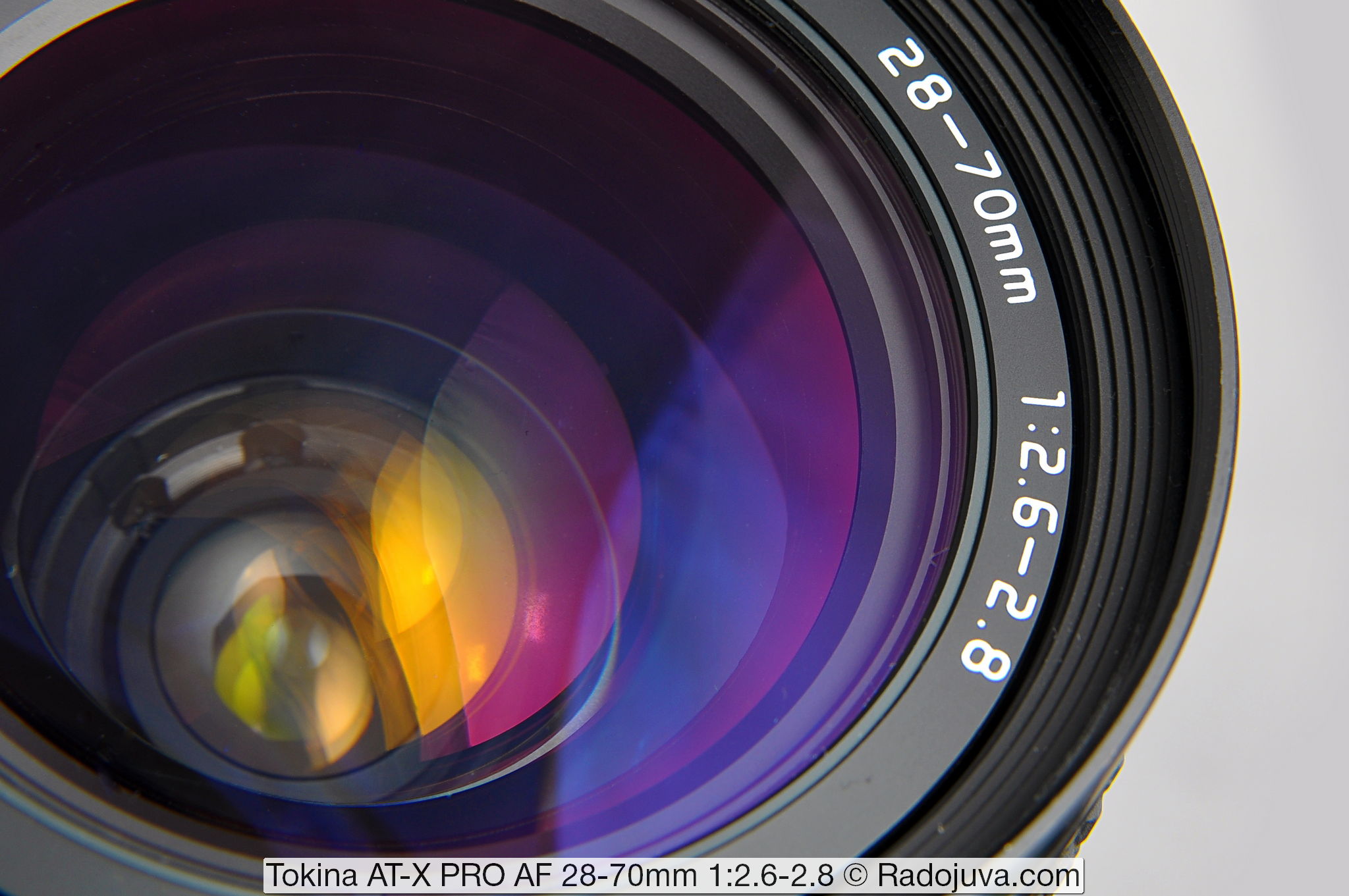
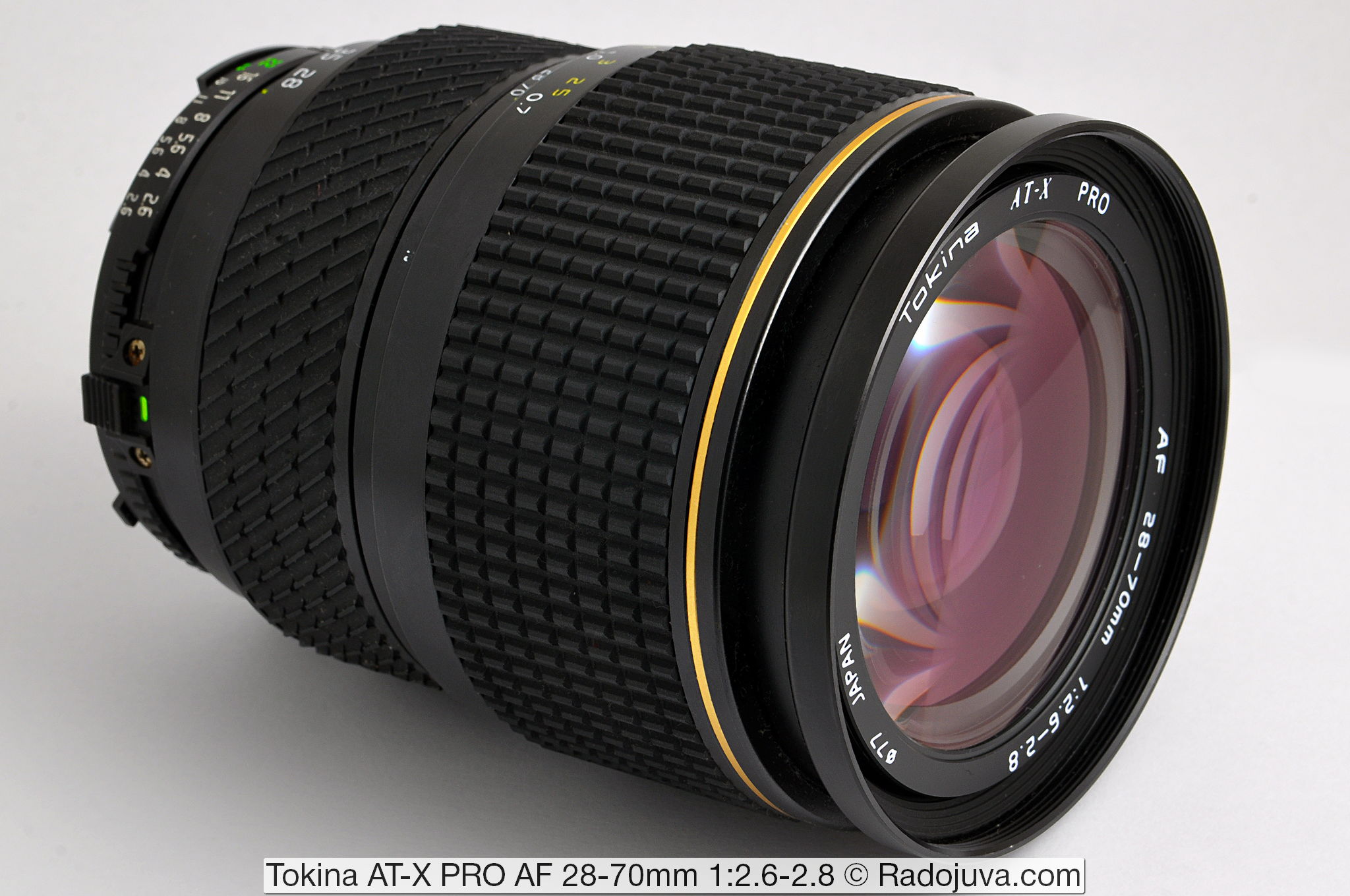

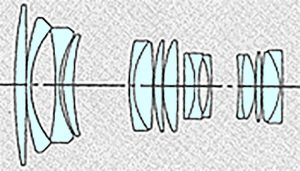
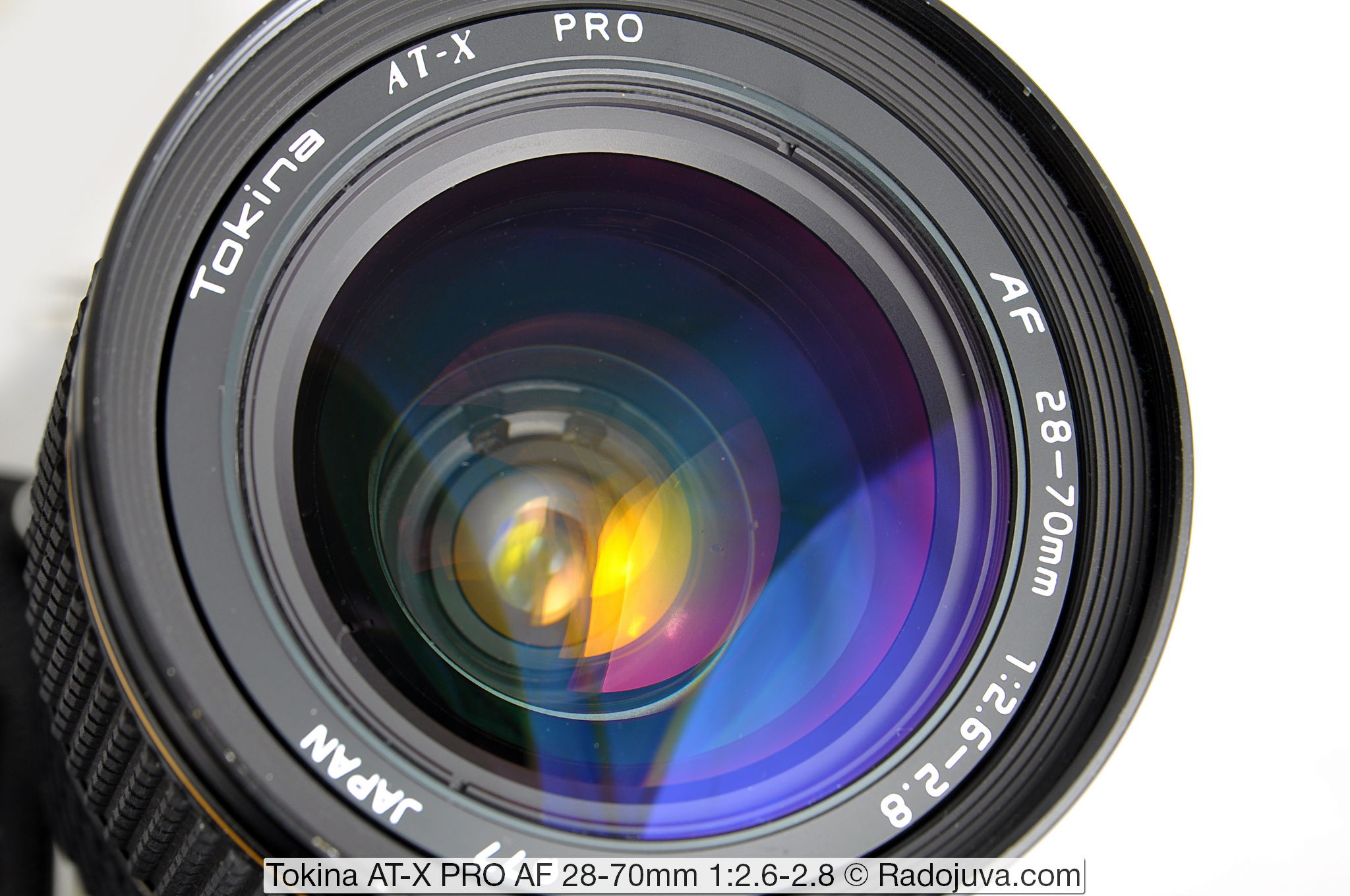
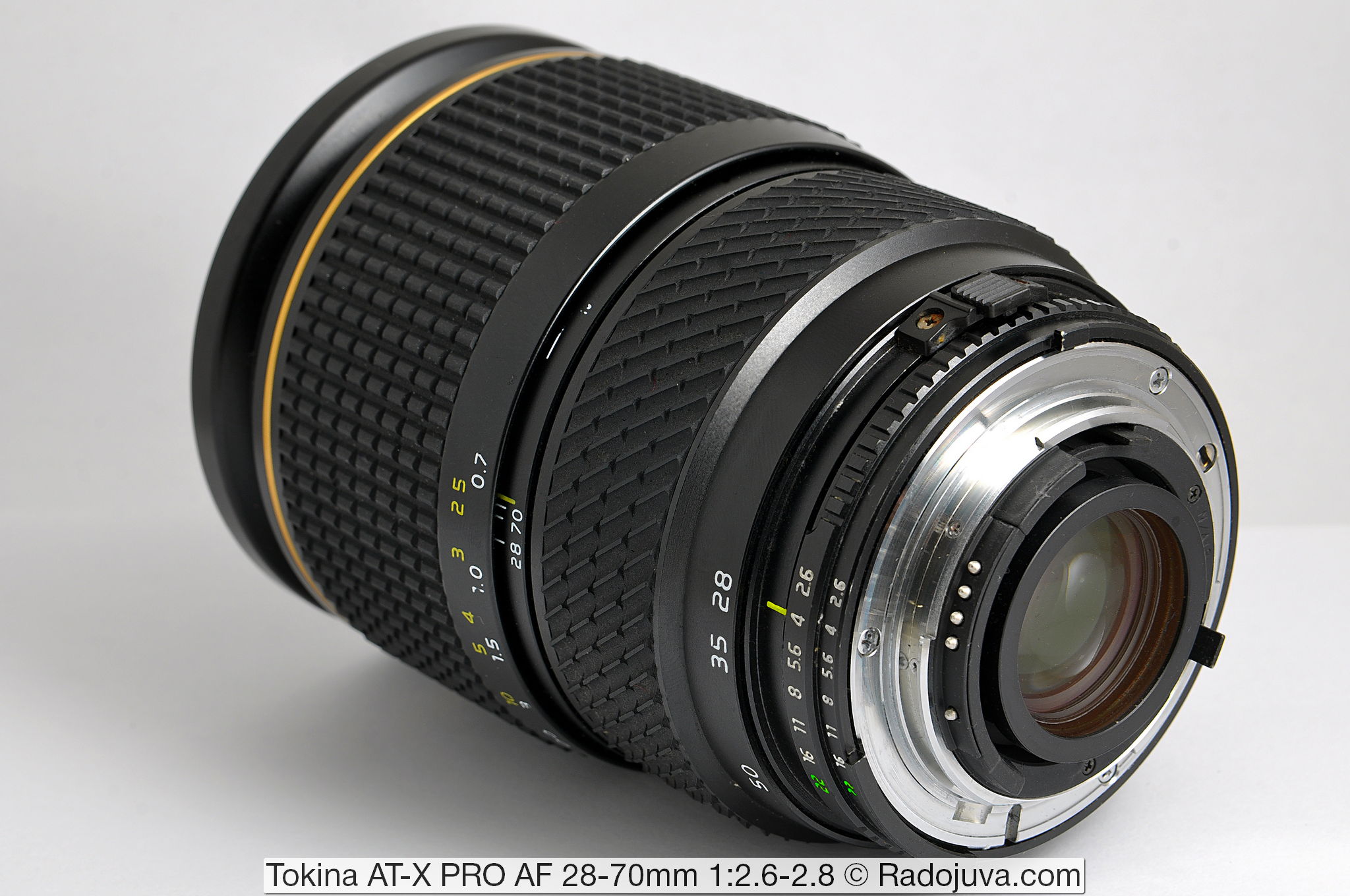
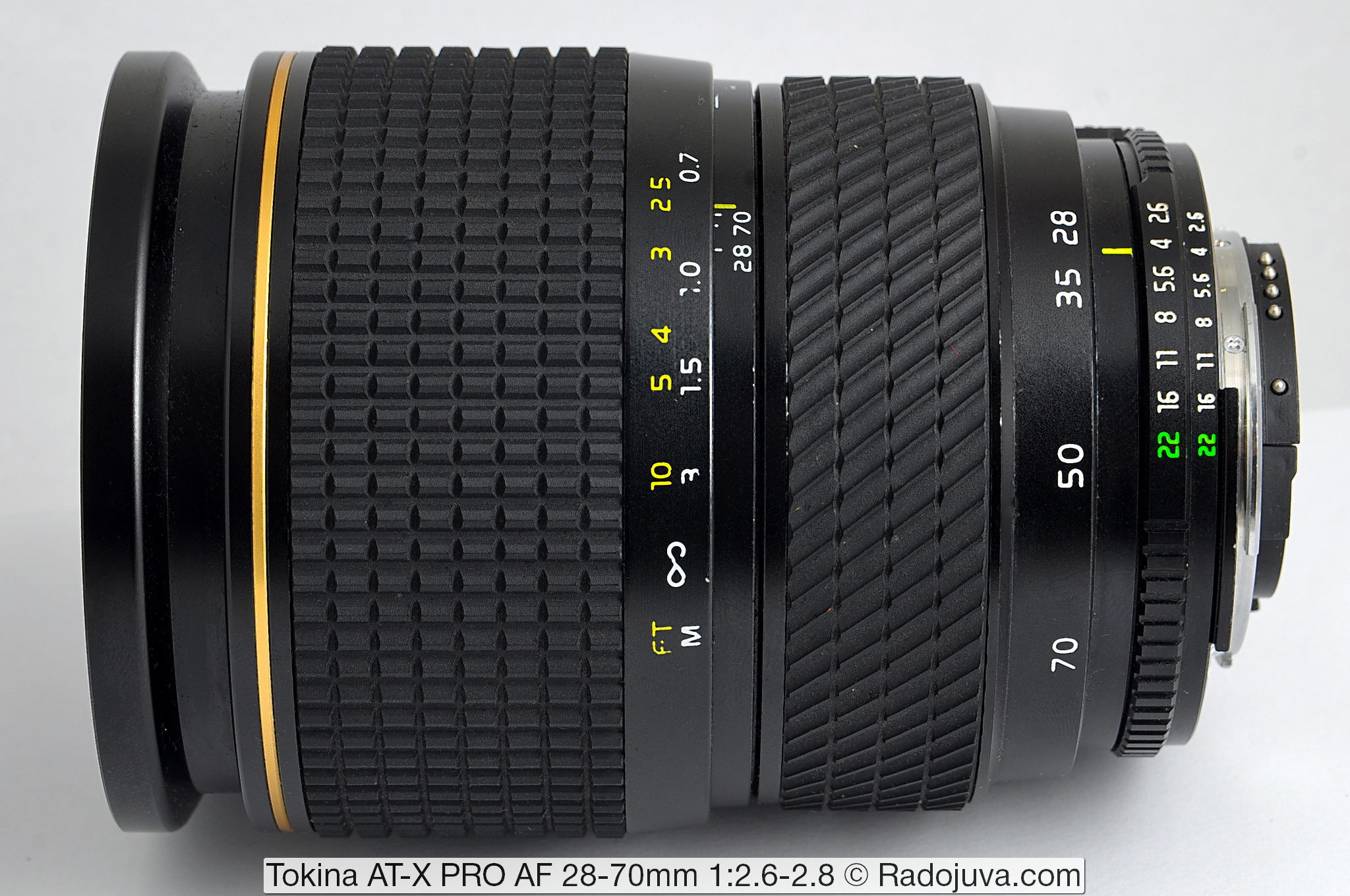




















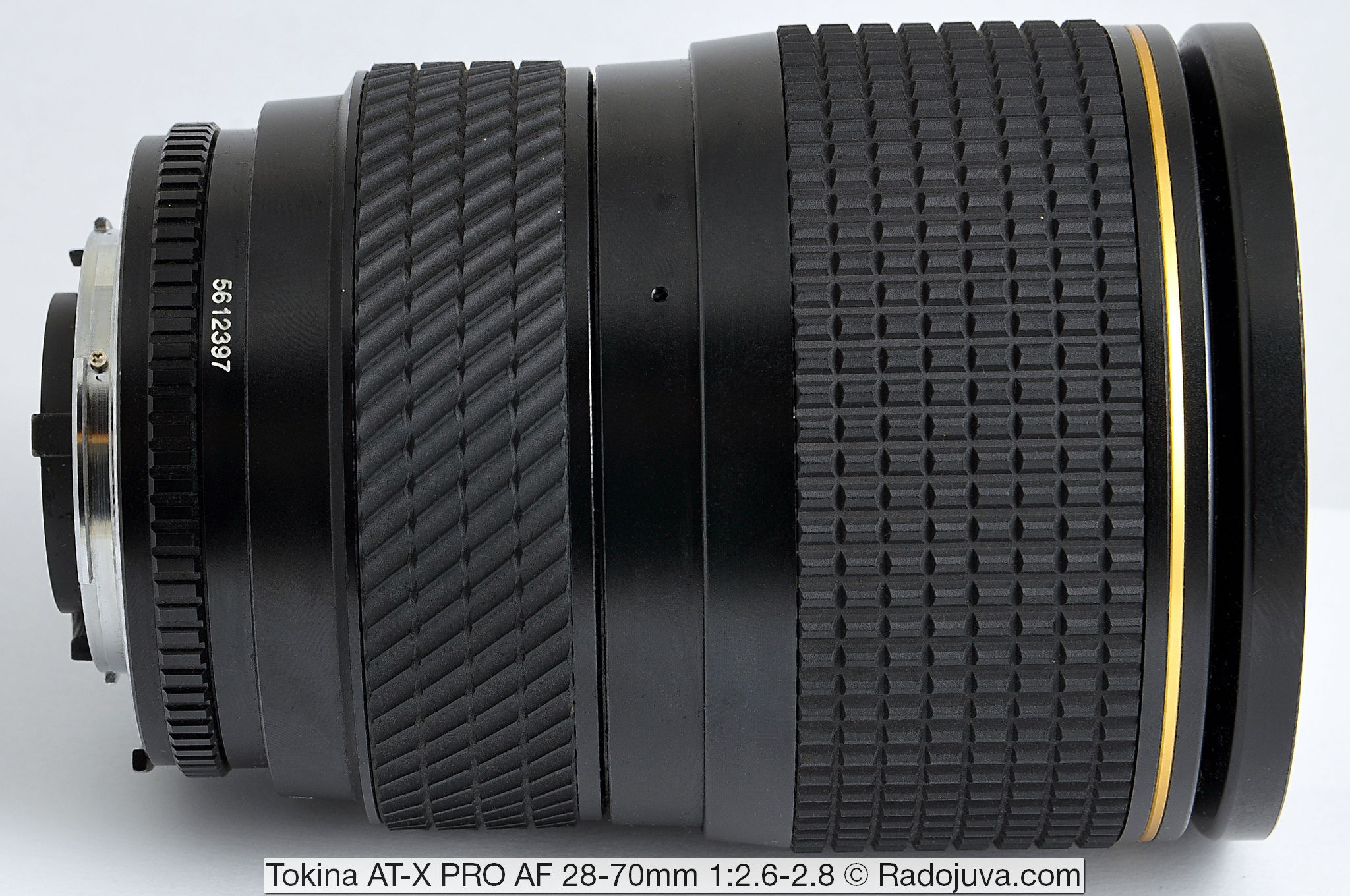
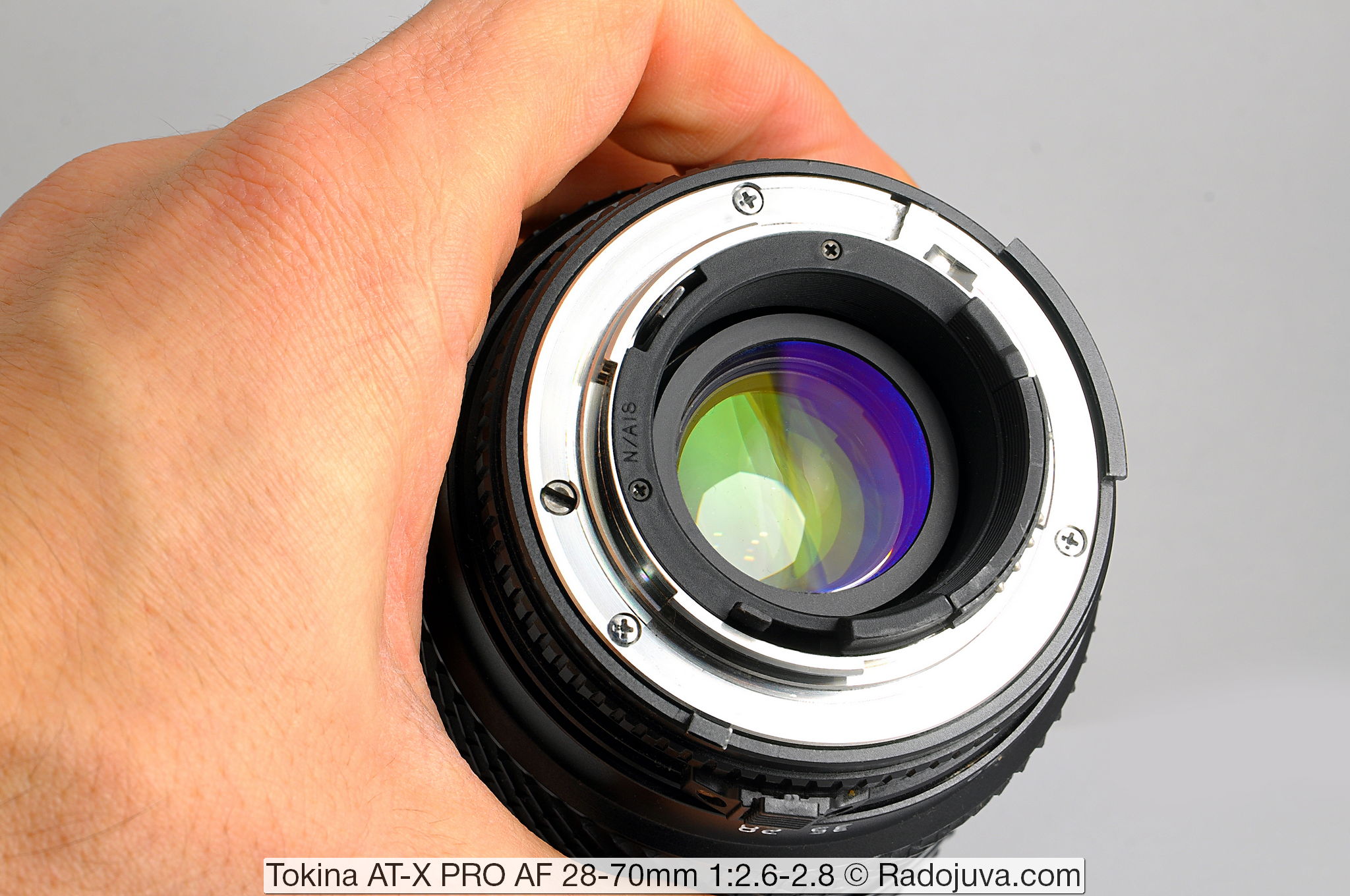
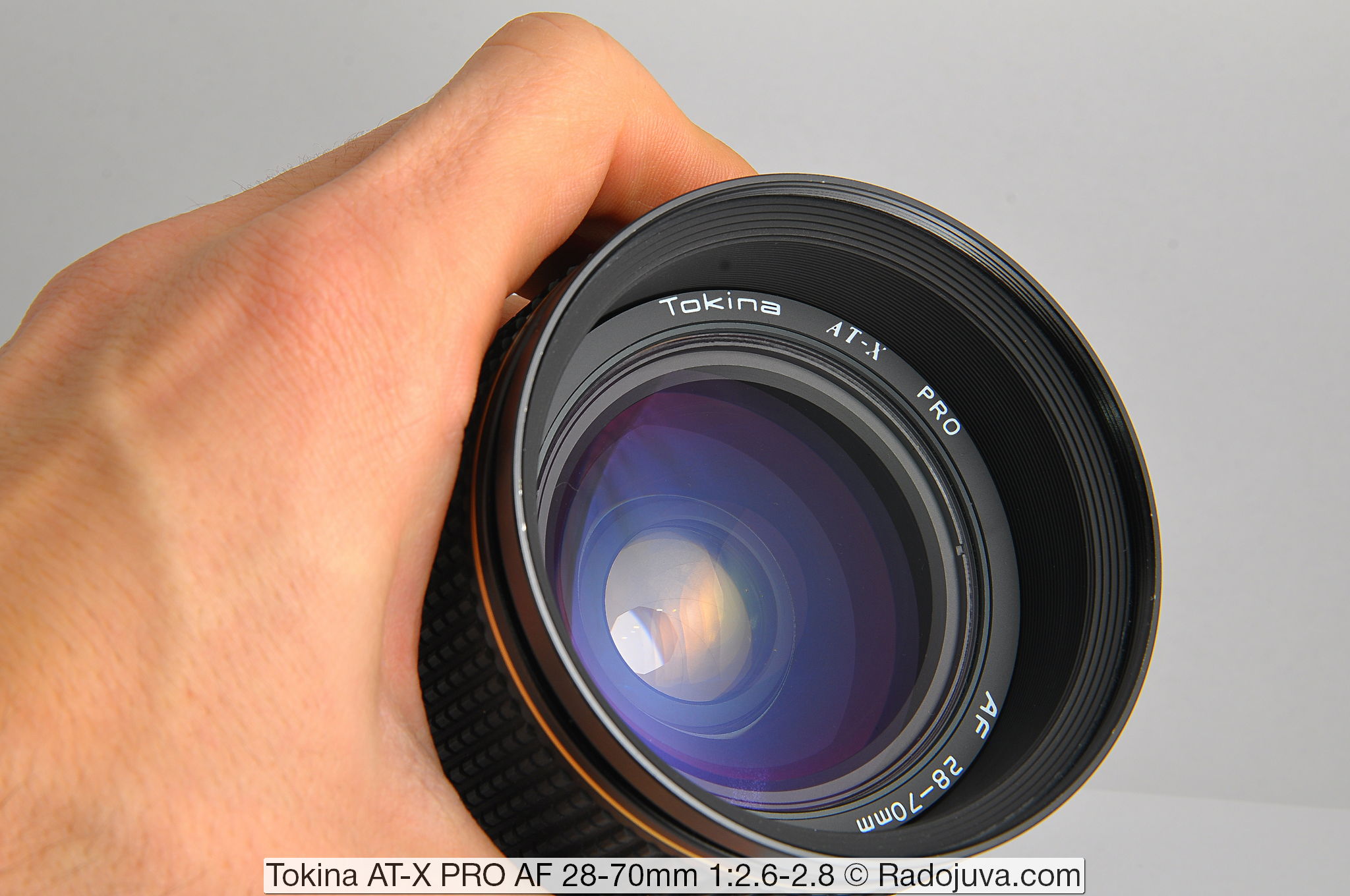
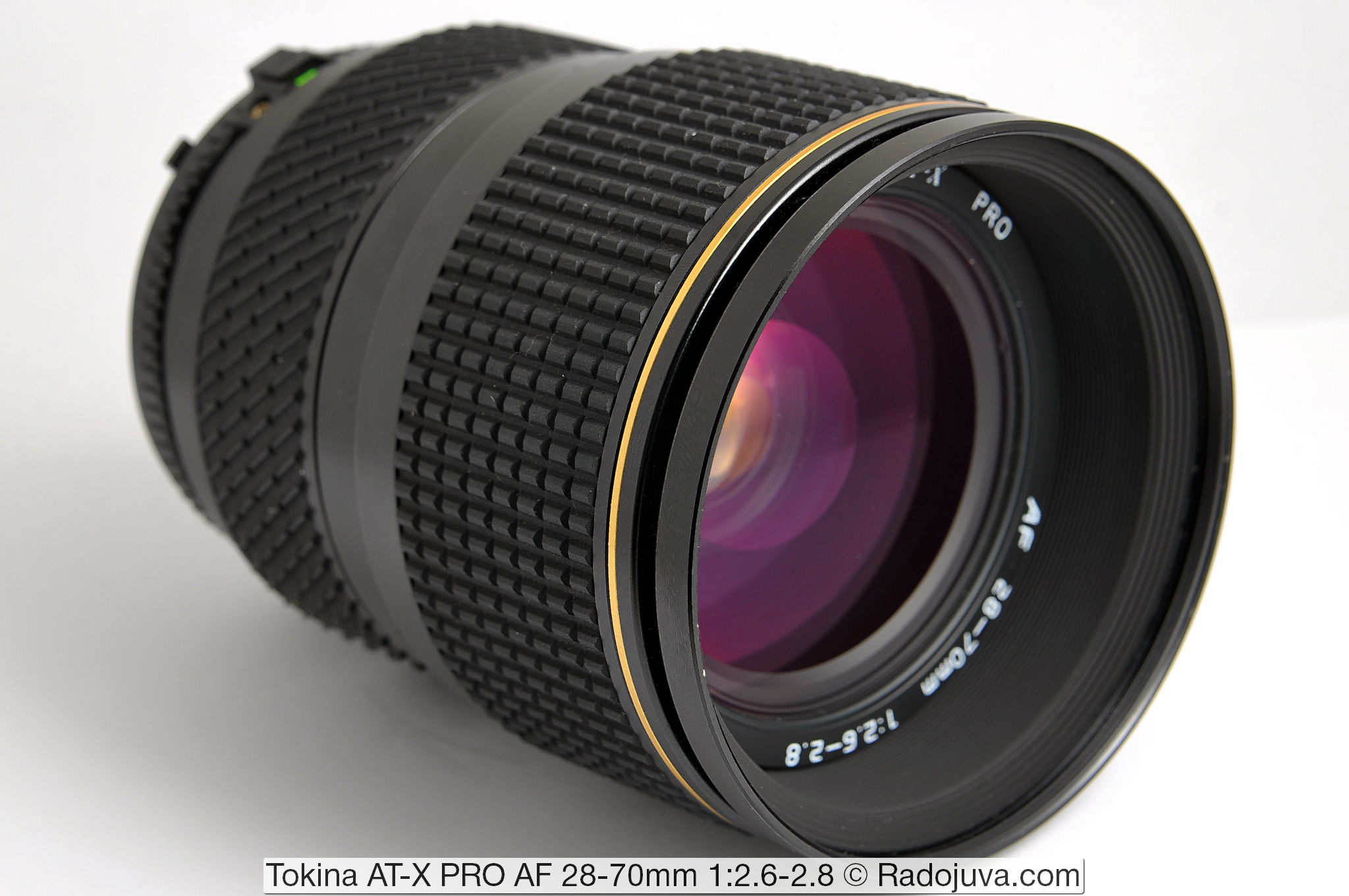

And even today's Tokins are lame
Is Tokina 28-80 / 2.8 optically better than all 28-70 / 2.8 series?
And if you compare them with Sigma 24-70 / 2.8 EX DG? It turns out Used Sigma 24-70 is more interesting than all Tokins?
Under "all Tokins" was meant 24 (28) -70 (80) /2.8.
In terms of "more interesting", then in my opinion, all the same - Tokina, but only as a "portraitist". Sigma - “more universal”, sharper in the center, along the edge, worse on the open. With cover - turns into a "razor". In addition, Sigma is the absolute champion in "haze"! But 24mm is not 28, and the MDF is three times shorter. Tokina's construct looks more reliable, and the cost of 82mm filters for Sigma does not add any positive features. Sigma's contrast is clearly better, but the color rendition is slightly yellow-green, but not critical. Tokinu without "software" is as easy to find as Sigma without back-front focus. But I still bought Sigma (EX DG MACRO, no motor), I have been using it for about 10 years. I'm not going to leave, but I look at Tokin, I want to. Both of them will surely lose to the old Nikkor 28-70 \ 2,8 in terms of the picture, but with the same margin they will bypass him in weight and especially in price. Dear Tamrons, known for their reliability, we will not touch.
Arkady and the owner of the lens Nikolai Tverdokhlebov - many thanks for the review! Now, if only a close-up portrait on the open, but with this wonderful model ... then I think that the rating of this "Tokina" would have risen greatly!
On the question of comparing Tokina and Sigma, I will attach an example on a similar diaphragm and a similar plot. To be honest, I sketched the glare from the flash, the settings were neutral, the sharpness was “5” out of “9”, I forgot to twist it, I slightly removed the excessive “sigma” heat, I just shot it in a camera jeep (out of laziness). I think it will help to understand the difference in the picture.
This could be removed at all with any lens, in any case, the photo will be winning ... :)
+
-
And the girl is not married? I'm getting married !!!
Well, you would have removed some twig ... Otherwise ... THIS IS ... You don't know what to evaluate :)
I think that similar photos with focus on busts can be shot on rahognanny 18-55 vr2 with sharpe and even normal without vrki)). When you look at the likes of this photo, you understand that the time of the old Tokyo glasses has irretrievably gone and the meaning in them is yours.
Thank you for your opinion and food for thought! :-)
model - fire)
I have Tokin 28-70, 2-8, excellent sharpness, I only shoot portraits, nature is rare. I am satisfied with everything in this lens. I got a good one ...
Kind. I have such a token for a long time. Shot on d90, d300. And I agree that the picture is not the best. But having tried it on ff. d700, D750 changed his mind. On FF he transformed.
I just have Tamron 28-75. Apparently, an unsuccessful instance got. Sharp removes only with f / 3.2-4.0, at 2.8 there is always soap :(
What to do?
My granddaughter found this site. I went to him, looked at articles about lenses, read reviews and comments and did not understand anything. Here, in the forum, in my opinion, there are no photographers who are keen on the end result, IMPRINT, PHOTO, but there are people who do not really care about photography as such, but the lines per millimeter are important. And it’s hard to call them techies, I can’t understand who they are. But what photographers aren't, that's for sure.
Well, here I, as the author of this review, have printed about 60-70 photobooks in a year (different, with different photographs), while working, I am ultimately looking at the end result. But if we are talking about photographic equipment, then there are nuances, opinions, and standards.
share your secrets of photography, and we will learn from you)
So you appeared in a new place and began your conversation like this: "You are all n ... s, and I am the Count of Monte Cristo!" Do you know what the answer will be to you? You know! Why, then, to start an acquaintance like that? Simply write: “Hello. I am an old-fashioned photographer. I'm used to the film! Your chips are not cut a little less than completely. Dude, explain what lines per millimeter are! " And what is most interesting will be explained to you! But tell me, why should you start with insults?
Indeed !
I bought a Tokina 28-70 pro sv, pretty cheap. Before that I read a lot of reviews ... someone is happy, someone is not very ... My copy was noticeably softened at f2,8. I did the following: under the lens mount there is a package of metal shims of different thickness, I removed one shim, the thinnest ... After that the lens was transformed, the picture acquired contrast and sharpness at all focal lengths and at all apertures. I use it on Nikon D3, focus correction +5 on the camera to this lens. Maybe my version of alteration lens is useful to someone.
2 Andrew:
“There is a package of metal spacers of different thicknesses, I removed one spacer, the thinnest ... After that the lens was transformed”
Please, tell us in more detail how you did this.
This is not the first time I have seen such advice on disassembling the lens and removing the gasket under the lens mount.
How difficult / dreary if you have never done this before?
I just think about buying Tokins of this class and it bothers me a bit that I have to disassemble the lens so that it normally works.
I unscrewed several screws securing the bayonet itself to the lens, and the contact pad is attached separately .. the bayonet can be removed without problems. The contact area remains hanging on the cable and it does not interfere. The entire disassembly and assembly operation takes several minutes. There is nothing complicated there. So do not worry. I pre-set the marker on all parts to put everything in place during assembly.
Thank you for your reply!
Are you sure the thing is laying
and not in the focus correction in the end? )))
Good day to all. I have had this kind of Tokin for about 7 years. At first I stood on the d90, now on the D700 and Fuji S3pro.
My personal opinion is that this is a very good lens, especially considering its price. The design is simply excellent, the speed and focusing accuracy are excellent. The color rendition is a little specific, but soft and pleasant. If we talk about his sharpness - yes, he is not a razor, but to call him not sharp - his tongue does not turn! At 70 mm by 2.8 branded software (not to be confused with soap), for someone it is a minus, for someone it is a plus. I like.
Front-back lens does not suffer, at least my copy. If asked to sell - I will not sell, this is a lens made with soul, has its own character!
I do not see any reason to compare it with a plastic Tamron, not in the picture, not in the design due to the wretchedness of the latter.
This lens is rather worth considering as art glass, although it’s not bad for reporting either (I shoot reports on Nikon AF Nikkor 35mm 1: 2D and I like the fix more for these tasks).
in pursuit
It is, of course, difficult to perceive Tokin's software as an artistic trick))) But at least a photo wherever it went ... It's not all the same as for me the glass is more for Avito than for serious work on it ... And what kind of reporting on soap can we talk about ???
Good afternoon! Tell me, where can I assess the condition and cost of this lens? I want to sell it, because I don’t use it at all, it just lies for several years.
Arkady for God's sake do not delete this quote from the Nikon Club:
“I decided to write a couple of words here based on my own experience of communicating with a couple of specimens of this glass (although there were other tokins) - perhaps, someone will help with the choice.
I personally met such problems in several instances:
1. Absence of infinity at focal 28-35 mm (while it can be at 50-70), when the focusing ring rests on infinity, but the confirmation sensor in the carcass does not light up (or blinks uncertainly). The treatment is quite simple - by removing several shims (1, 2, etc. - by trial and error)) located under the diaphragm ring. I managed it in about 1 hour of unhurried work: first, the black plastic cover on the bayonet and the contact pad, the metal bayonet itself, which is on 3 screws, is removed - do not unscrew the diaphragm calibrator !!! - then, the diaphragm ring is removed (it is better to put the hole at 2.6 initially) together with the * screwdriver * drive (do not lose the retaining washer!). Under it there will be gaskets - one thick and several thin (almost like foil), springy. Here, exactly thin (or thin) and delete. Despite their insignificant thickness, this is enough for the optical center of the lens to become closer to the matrix, and infinity appears. We clean / lubricate the AF drive (if necessary) and assemble in the reverse order, remembering that the bayonet screws must be tightened alternately and very evenly (like a wheel on a car!)), So as not to distort the mount and not get * soapy * corners diagonally or on one side of the frame.
2. Front focus at 50-70mm. Alas, I don’t know how and where to reprogram the Tokin * chip *, therefore, without hesitation, I refused such copies (on mine there is neither FF nor BF, therefore, such exist in nature)). You can, of course, make different AF corrections for different focal lengths or focus, for example, at 35 mm, and then shift the zoom to 50-70 (the focus of the lens, according to my observations, does not shift when zooming), but this is all for the amateur .. Many people take this FF for a very strong * soft effect *, although to exclude it, it is enough to remove the target at 45 degrees and check the AF accuracy. Of course, the * soft effect * itself, or rather spherical aberration (or * coma *), is present at 2.8, and at all focal points, but it seems to be superimposed on top of a sharp image. It's just that 70mm DOF is much less than 28mm, and FF becomes more critical. ”
Treatment option disassembly of the lens.
You can see step by step here: http://shadowrcd.livejournal.com/632.html
Of course, I generally delete only insults, off-topic advertising and politics :)
Maybe I don't understand something, but what kind of front and back tricks can a lens with a “screwdriver” have. These problems seem to exist only for lenses with internal focusing motors.
For a long time I chose a fast zoom 24 (28) -70 F2,8 at a reasonable price and stopped at that. I chose from Tamron, Sigma and Tokina. Nikkor can't handle ... There is a lot of criticism on different sites for each manufacturer - unreliable internal focusing motors, flimsy plastic mounts, backlash, etc.
So about this lens, add my 5 cents.
Full frame vignetting at 28 and 35mm is very noticeable. The hood “climbs” into the frame even at 50mm. Small software is present on F2,8 70mm, but little noticeable on 28.
I even liked the software for portraits of women. my Tamron SP AF 90mm 2,8 Macro, having razor sharpness is good for a man's portrait. Women are afraid of his drawing - it emphasizes age and skin defects. It must be blurred.
I also noticed focusing "yaw" when shooting low-contrast objects at F2,8 70 mm - a consequence of the software. And of course the lens gives a shadow for the built-in flash.
I did not notice other serious flaws.
the front and back focus can easily be with any lens, for example, the focus may be a shift in the focus module, poor alignment of the mirrors and the focus sensor, curve focusing of the focus sensor (they align on one lens in the service), etc. The same can be applied to the back front of the focus directly related to the problems of the lens.
That is, this is a problem with the device, not the lens.
in the same way the problem can be in the lens, I just gave an actual example, when 100% will be a problem.
Recently I bought myself this Tokina.
The version really differs from the one in the review - I have it with pebbled paint, the letters CE (European Union marking after 1999), without Tokin's inscription next to the lenses. The hood, like the Sigma 28-70 / 2.8, is screwed into special grooves, and not into the filter thread. While testing and comparing with the existing Sigma 28-70 / 2.8.
So I have a shagreen 28-70 / 2.8 AT-X PRO II.
I was waiting for soap and strange image quality, but my copy is noticeably sharper than the Nikkor 35-105 / 3.5-4.5D or the old SIGMA 28-70 / 2.8.
Sharpness is really good.
Aperture 2.8 is inoperative - a whitish veil and too soft a picture.
With 4.0, everything is already very, very worthy and starting from this diaphragm there is already a working picture.
The picture is neutral, there is no departure in warm colors, like on Sigma.
Everything seems to be fine, but as always there is one "BUT".
No, this is not focus. With her, oddly enough, everything is fine too.
And even at 50-70mm the glass does not lather and there is no white shroud.
The problem is the operation of this glass with the exposure meter of my full-frame Nikon.
There is a matrix metering, as universal.
If 35 / 2D and 35-105 / 3.5-4.5D beat exactly and what you see in the viewfinder, then you get the result. Sigma 28-70 / 2.8 I got NON-D and it staggers - for some reason the picture is often underexposed by 28-35EV at 0,3-0,7mm. At 50-70mm, the opposite is true. But I'm used to it and everything is within reason with more or less even lighting.
With Tokina, the camera stubbornly tries to overexpose the picture - the shutter speeds are noticeably longer.
I compared Sigma and Tokin by changing lenses and shooting the same landscape at different apertures at different focal lengths. And if Sigma is almost always a predictable result, then with Tokina it turns out a lot more marriage. Only at -1.0EV -1.3EV does something get closer to the truth. But he turned the other way and even with such settings everything was lit up, turned another 90 degrees, returned the previous settings and vice versa received an underexposed picture.
I will continue to test and try to understand this glass ...
- I also have an old Sigma 28-70 / 2,8 lens - all these film optics differ in a not very working open diaphragm and become sharp only after covering up to 4,0, and therefore on my D600 I often use the tiny and light Nikor 28-80 glass / 3,3-5,6G, if it were not for one thing - the heavy Sigmas and Tamrons of the old era, nevertheless, have their own drawing and bokeh, which many people like, and at a wider angle for shooting landscape or architecture - everything is one , you have to plug the diaphragm to 5,6-8,0 ...
Modern lenses, of course, are already a couple of steps up in relation to optical characteristics, durability and reliability of autofocus, but for those people who do not cut money from a photograph and do not have extra money in their wallet - old lenses can still quite bring joy to their owners and especially considering their cheap cost, which is important in the conditions of the collapsed exchange rate of the hryvnia, ruble and our Kazakhstani tenge ...
Once again, I checked in sunny weather. What is overcast, that in the solar exponent the camera behaves the same.
It’s as if it’s worth measuring at a central point or center-weighted, but in fact it’s matrix.
Without adjusting the exposure in the aperture priority mode, the camera sets the minimum ISO in the afternoon and seeks to set the slowest shutter speed. As a result, the picture is overexposed and difficult to correct.
At -0,3EV a little better, but still bad.
At -0,7EV everything already starts to look like the truth.
At -1.0EV everything is as it is in reality, quite a bit underexposed.
At -1.33EV, the picture is slightly underexposed.
Damn, I have this glass explodes the brain :(
I tried it now for everyone and realized that without -0.7EV, you don’t even have to go outside (in any weather).
And if there is no working 2.8 then the meaning of the lens in general? If the manufacturer writes with a knife on the body of the letter PRO, then there should be no talk about the OPEN APPLICATIONS 2.8. Well, for me. Well, at least neither boots nor Nikon nor Olik allow this. Conclusion???
- for boots, oliks, nikons or Sigm Art series - and the price is completely different, and the ABM inscription corresponds to that film era, and as regards the unsharp 2,8 - so at the long end where we shoot the portrait, often the sharpness is not most importantly, but at wide angles, where we usually shoot a landscape, or when shooting groups - we cover the aperture to 5,6-8,0 ...
Guys, tell me, there is a token 20-70 about St., they suggest changing to a tampon 17-50 I understand that they are different focal, but is such an exchange worth the price and quality?
It was possible to compare the 28-70 / 2.8 AT-X PRO II and the AT-X PRO 28-80 1: 2.8 Aspherical N / AIS.
The first one works with my camera is not very stable - as I wrote earlier, I have to constantly monitor the metering and set the -0.7EV correction, otherwise the camera tends to set a longer shutter speed in the aperture priority mode than necessary, and the picture becomes overexposed. Now I also noticed that the camera tends to lighten the first frame, and make the next a little more accurate (in the sense of a little darker). Sharpness floats - in the 0-35mm range it is maximum, 50-28mm less, 35-50mm even less. Checked on a closed diaphragm to 70.
At 28-80 / 2.8, you also have to track the metering. But the camera works with this glass a little more accurately and the -0.3EV corrections are more likely, while at 28-70 / 2.8 you need to set -0.7EV under the same conditions.
The sharpness of the 28-80 / 2.8 is slightly better than the 28-70 / 2.8.
Compared on fotkanii brick wall of the house opposite. The weight of files at 28-80 / 2.8 consistently turned out to be more. Sharpness in the range of 35-50mm is again maximum, at 28-35mm it is almost the same. At 50-80mm falls, and the more to 70-80mm, the more soap. Although the picture is not much worse than 28-70 / 2.8, in the range of 50-70mm. About the same.
In the range of 70-80mm, the 28-80 / 2.8 is noticeably lighter (more than 70mm for the 28-70 / 2.8) the picture - the shutter speed increases.
28-80 / 2.8 is noticeably larger and heavier than 28-70 / 2.8.
28-80 / 2.8 more emphasis on green than 28-70 / 2.8.
This was confirmed to me by the Japanese from the flikra, which uses 28-80 / 2.8 on the D3S.
Focusing is fast enough with both lenses, but 28-80 / 2.8 misses more often than 28-70 / 2.8. M. b. didn't work out with my camera - xs. The percentage of misses is small, but it is there.
I do not know what this is connected with. There seems to be no back / front focus with my camera. Specially rechecked.
At 28-80 / 2.8, it seemed to me that distortion was more and more unpleasant in the range of 28-35 mm than in 28-70 / 2.8 in the same range. The camera (old FF Nikon) does not automatically correct it.
The distortion is not as terrible as on the old Sigma 28-70 / 2.8, but it is very similar.
I forgot to add both at 28-70 / 2.8 and at 28-80 / 2.8 the aperture 2.8 is not working.
And here and there soap and whitish “veil” (aka Tokina glow).
Everything becomes working on aperture 4 and above.
no need for such photos if you are doing a lens review!
so who the hell is he needed now ..))
Optical design of the original Anginieux 28-70 / 2.6
Optical design of Tokin 28-70 /2.6-2.8
Appearance of Tokin 28-70 / 2.6-2.8 and Anginieux 28-70 / 2.6
Heavy ... with the Sony A77 carcass in active shooting mode, the brush starts to ache after half an hour / hour of work. However, the weight distribution is very successful: you can literally hang the camera on your fingertips with the protrusion of the holder. But that's okay.
According to the picture: excellent color rendering. The colors are so natural and saturated as in their own eyes.
Excellent sharpness at 4-4,5 at any focal point. My copy "cracks" a little during autofocus, but this is not critical, because it focuses fast enough. But I’m more pens ... not the point.
Yes, there is software, but it is very visible at f2,8 at 70mm. But I don’t use it almost like that.
and, yes ... Heavy ... one more time.
And how does he manage the crop matrix at 24MP? No complaints?
Dear experts, welcome! Please answer the question on tokina 28-70 2/8 af at-x, which is old with 72mm thread, why my d5300 camera doesn’t work with this lens, it’s more accurate how it works, but when I set the aperture to 22 and I switch the cradle, nothing happens, writes that I need to set the aperture to 22 and fix it with the lever, though I already did it! what could be the problem?!?
There is NO screwdriver in your camera. There is no built-in motor. It is without a motor lens, and therefore, nothing works.
It was necessary to take d7000 / 7100/7200 ...
Thank you, autofocus will not work on my camera, but all other functions should work properly.
The screwdriver has nothing to do with iris control. Aperture, exposure metering, focus confirmation, flash operation with this lens and d5300 should work like any other AF-S / AF-I / AF-P lens that simply has autofocus disabled.
Most likely, the protrusion of the EE lever is slightly bent on the lens. You can set the F / 22 value on the lens ring, and This one drown the lever, for example, with adhesive tape. Maybe just look at why the protrusion on the lens doesn’t drown him.
Thanks Arkady, an intelligible answer! Arkady, do you think it was not in vain that I bought it on crop!? Given that I, as an amateur, do not really like strong sharpness, I like the softness of the pictures more.
Honestly - if you bought it, it means you had an idea of what you want to use, and then direct hands and desire) I myself recently decided to purchase a 28-80 ATX PRO, I'm waiting for it to be brought.